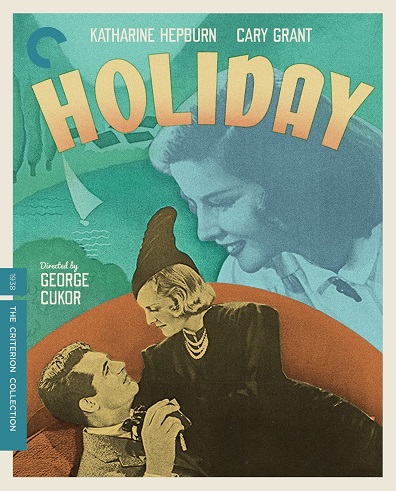
Holiday
Studio: The Criterion Collection
Jan 10, 2020
Web Exclusive
![]()
Holiday, George Cukor’s 1938 adaptation of Philip Barry’s play, will likely be a bit of a curveball to any fan of the more popular collaborations between its stars, Cary Grant and Katherine Hepburn. The screwball lunacy of Bringing Up Baby and the effervescent romance of The Philadelphia Story are well remembered by fans of classic cinema - few remember the uneven but fascinating Sylvia Scarlett, featuring a cross-dressing Hepburn - and the logline for Holiday would likely conjure similar ideas of madcap hijinks and mistaken identity. Grant stars as Johnny Case, a rags-to-riches dreamer who clashes with the father of his old-money fiancee while developing a bond with her sister, played by Hepburn. And although it strikes some of the same notes one would expect from a Grant/Hepburn/Cukor joint, the tune it plays is of a more melancholy variety.
The film’s slightly different register is best exemplified by its two stars. Superficially, Johnny Case doesn’t seem like much of a stretch for Grant as he approached the height of his stardom; energetic, witty, a bit of a smart-ass. So many of Grant’s protagonists - even the romantic ones - have a peevish, put-upon note to them, as though the actor found amusement in being mildly unhappy at the task of being a debonair leading man. But while Case certainly has the big kid energy of a Grant character - he performs both a cartwheel and a somersault in the first ten minutes of the film, the former out of excitement, the latter out of boredom - he lacks the irritability and comic belligerence of so many of his alter egos. Johnny is disarmingly self-possessed, completely unbothered by the side eye he encounters as he moves among the ultra-rich. Case’s plan to earn just enough money to retire young and spend the rest of his life finding himself is incomprehensible to the blue bloods he’s marrying into, who can only see money as a means to more money. The zen-like cheerfulness with which Grant plays Case makes him something of a Manic Pixie Dream Boy, perfectly comfortable with the mild discomfort he causes others, but charming them all the same.
While Grant’s Case is unashamed of his humble origins and - comparatively - modest goals, Hepburn’s Linda Seton is adrift in her own unhappiness. A budding leftist who shares Johnny’s disinterest in the trappings of wealth, Linda lacks his sense of purpose and self-actualization. On paper, the character is a privileged rich girl who needs to be taken down a peg, an archetype that Hepburn would perfect over the course of her career. But as Linda, she dials down her mile-a-minute delivery and megawatt smile just enough to make the character believable as a wallflower who wants more from life but has no idea what more is. Most romance stories focus on the passion and intensity of new love, but Cukor and screenwriters Donald Odgen Stewart and Sidney Buchman wisely build a friendship before they build a romance. Johnny and Linda don’t fight like cats until they fall into each others arms as in so many similar films. They exist together as discrete individuals until we - and they - realize they’re right for each other.
The middle third of the film takes place almost in real time, at a combination New Year’s Eve/engagement party for Johnny and Julia, Linda’s more traditionally minded sister. The spacious party atmosphere gives Cukor a chance to reinforce the film’s vibrant humanism via a terrific cast of supporting characters. Lew Ayres gives a restrained mournful performance as Ned, Linda and Julia’s failed drunken musician of a brother. The character could easily be comic relief, but Cukor and his writers clearly have a sense of respect and care for Ned, who is always sad but never pathetic. Equally fascinating are Edward Everett Horton and Jean Dixon as Nick and Susan Potter, Johnny’s surrogate parents. A pair of proto-bohemian - possibly communist - professors, the Potters become the main characters of the film for almost ten minutes at the top of the second act, arriving at Johnny and Julia’s engagement party and feeling wildly out of place amongst the stuffy, grasping rich. They naturally gravitate to Linda at the party and their mocking of her snooty cousins - they effectively call them Nazis - is the film’s most overt but still delightfully witty framing of the its own thesis; greed, the patriarchy and authoritarian rules bring only misery. Happiness is being true to yourself and sharing that with other people. It’s a simple message, but one the film conveys with measured delicacy and genuine heart.
Criterion’s new release of Holiday features a wide ranging and illuminating conversation between filmmaker Michael Schlesinger and film critic Michael Sragow, as well audio excerpts of interviews with George Cukor. The most notable supplement is the pre-Code 1930 version of the film, presented in its entirety. Directed by Edward H. Griffith and starring Robert Ames and Mary Astor - as well as Edward Everett Horton, who plays Nick Potter in both versions - it plays like a stagy sketch of the Cukor version. Grant and Hepburn are hard acts to follow, even when you’re preceding them by almost a decade.
(www.criterion.com/films/28829-holiday)
Current Issue

Issue #72
Apr 19, 2024 Issue #72 - The ‘90s Issue with The Cardigans and Thurston Moore
Most Recent
- 12 Best Songs of the Week: Charly Bliss, Jessica Pratt, The WAEVE, Hamish Hawk, and More (News) —
- John Carpenter on ‘Lost Themes IV: Noir’ (Interview) —
- Thomas Powers (of The Naked & Famous) Shares New Single, “Empty Voices” feat. Julien Baker (News) —
- illuminati hotties Shares Video for New Song “Can’t Be Still” and Announces New Tour Dates (News) —
- Jordan Lindley Shares New Single “Sometime Someday” (News) —

Comments
Submit your comment
There are no comments for this entry yet.